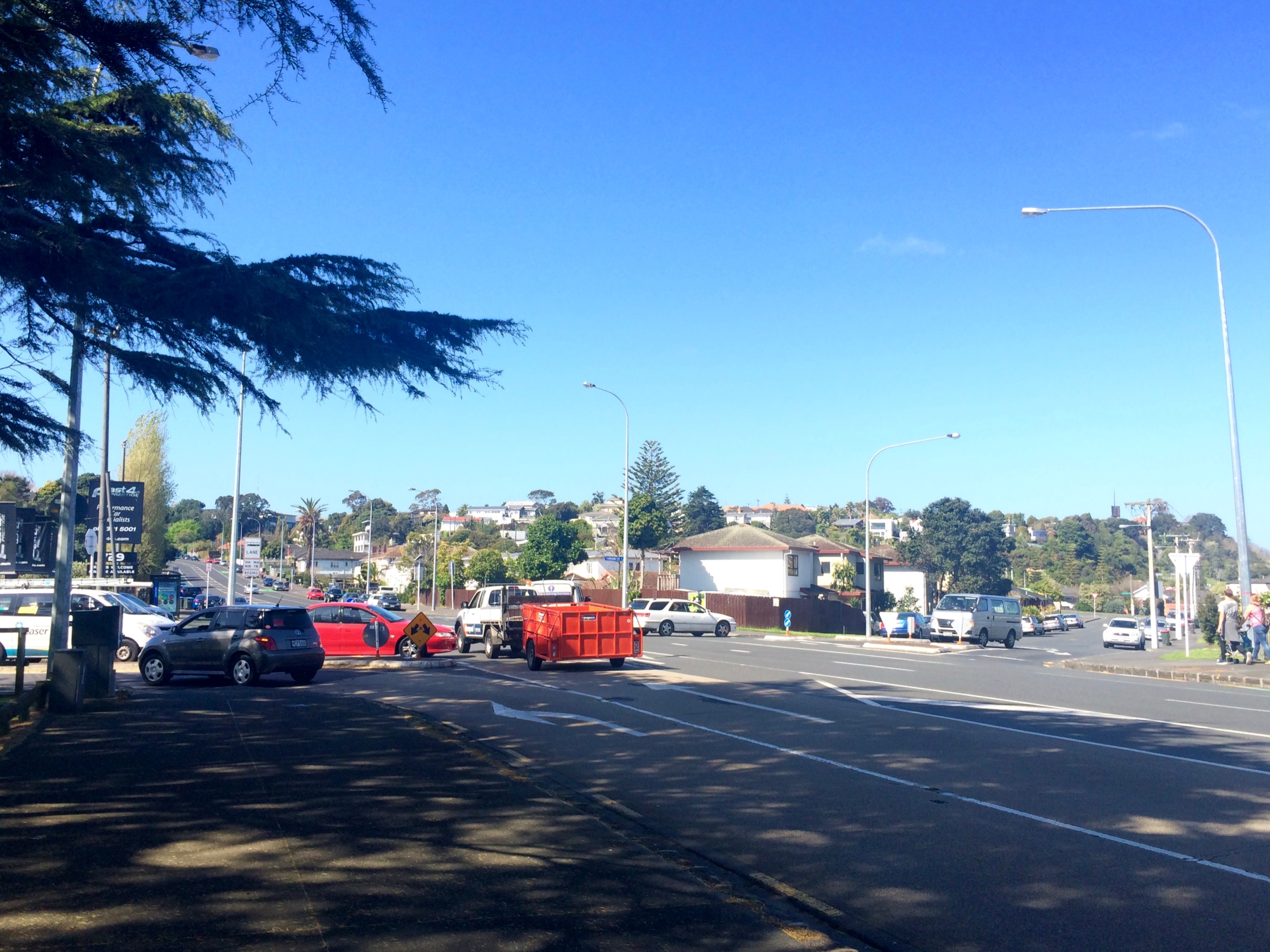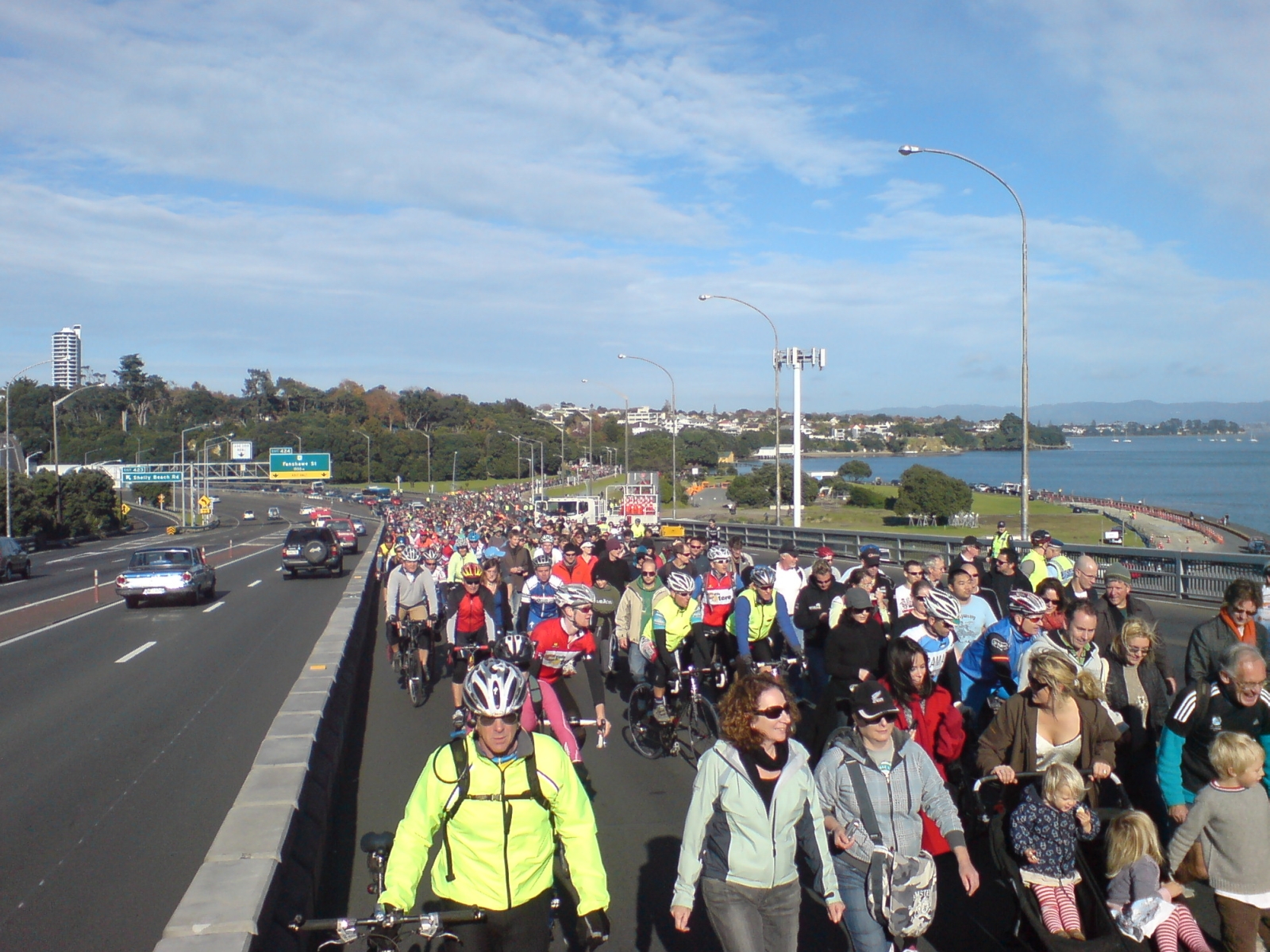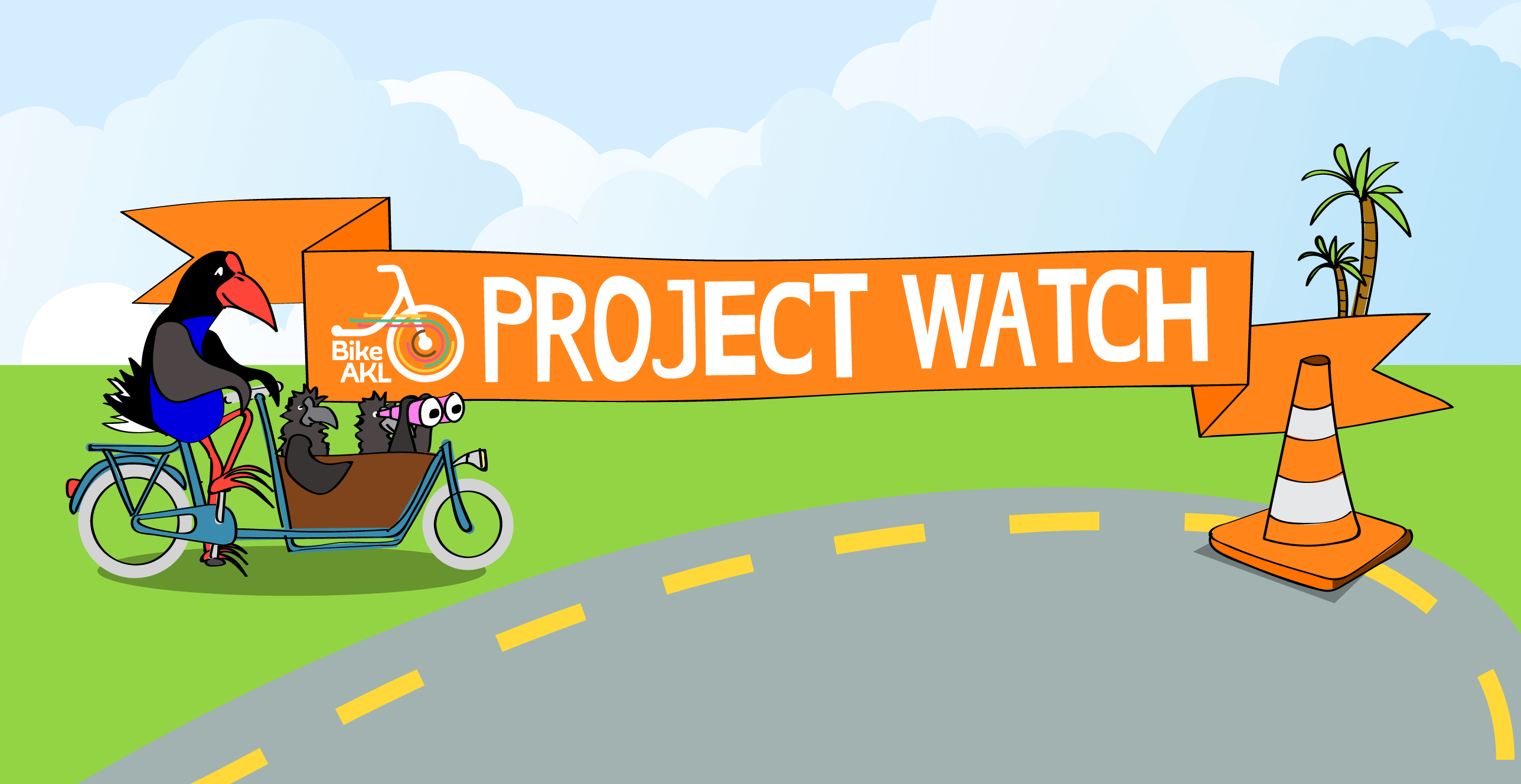Earlier this year, our regular contributor Duncan Laidlaw had a run-in with a car where Great North Road intersects with Bullock Track – and discovered he’s far from the first.
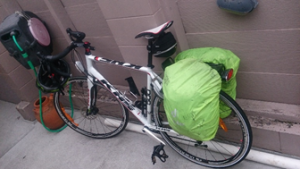
It’s the day before Anzac Day, and I’m heading into town on my Christmas bike – the best bike I’d ever had (visiting my family over Christmas, they’d they thought we were joking with the text message that said “Just stopping at Taupo for lunch and bikes” – and then we arrived with two new road bikes on the back of the car.)
In my kerb side pannier I have a camp stove and all the kit to make coffee at sunrise with the Sunrise Coffee crew.
The bike is eating up the kilometres, having just been serviced. It has run well for the 35 km travelled so far this morning. As for me, closing in on 9,000 km over my first 12 months back in the saddle regularly, life feels good, and things are shaping up for a beautiful sunrise on the waterfront.
Approaching the city down the Northwestern Cycleway, you have a few options for routes. The highly visible and well-advertised one is of course Grafton Gully, with its recent extension along Beach Road. Ian McKinnon Drive and Upper Queen Street do involve a fair amount of climbing though, so on that morning back in April I was using a route I had been running since March.
The new route takes me off the cycleway and across the motorway at Carrington Road, then onto Great North Road through Grey Lynn, then eventually along Karangahape Road before heading down Symonds Street to the waterfront. No off-road cycle paths, but for someone who rides Tamaki Drive daily, the bus lanes along this route provided what I thought was adequate space and comfort.
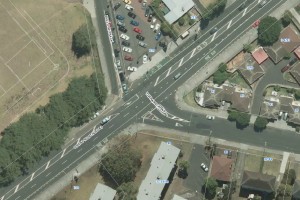
Except for one intersection, awkward enough to raise suspicions: Great North Road / Bullock Track. As it transpires, this intersection has been a known problem for many years, and is yet to be fixed – and I found out the hard way.
My ride ended abruptly when a car failed to give way at the stop sign at the bottom of the Bullock Track, driving straight into the left side of my bike as I was passing.
Fortunately, my short flight over the handlebars resulted in little more than bumps, bruises and some swelling. While it wasn’t very pretty, I was back on another bike the week after. Unfortunately the bike I was riding did not make it through the accident. The left front of the car connected with the left rear of my bike, which sent me clear but damaged the alloy frame, so it is no more.
Great North Road / Bullock Track – a known major hazard
We hear a lot about the intersection at Ngapipi Road and Tamaki Drive, as one of the worst cycling blackspots in Auckland. We know AT has plans to rework it, but as we saw last week, the lack of progress has already claimed another victim – who thankfully seems to have gotten off similarly lightly as I did. Either case could have gone a lot worse.
Indeed, Ngapipi Road/ Tamaki Drive is in at number 10 on the nationwide High Risk Intersections Guide Top 100, which ranks intersections based on accident frequency and severity (see NZTA’s “Briefing Notes: Crash Analysis” from June 2014).
Bullock Track actually ranks worse – It’s number 7, and as such is the 3rd highest risk intersection in Auckland. Also the worst overall in an urban setting with a 50kph limit.
The numbers show why: 48 minor injuries, 5 serious injuries and 1 fatality from 2003-2012.
On average, more than 5 people a year have been injured at this intersection over the last 10 years. It is worth noting that these numbers are only for reported incidents, and also that they don’t differentiate between cyclists, motorists and pedestrians. So this ranking should be a warning for motorists, not just more vulnerable road users.
What are some of the issues around this intersection?
The NZTA notes indicate that the most common risk issues on urban roads are: failing to give way / stop, and crossing or turning. And this is a hot spot for those movements, especially at rush hour.
There are traffic signals at the nearby intersection with Surrey Crescent and Great North Road, and at both ends of the stretch of Great North Road that passes MOTAT. But when it comes to the Bullock Track (one of Auckland’s steepest streets, and often used in the rush hour as a rat run to the motorway or a shortcut to Grey Lynn), neither end is signalled. And it’s the bottom end where I came to grief.
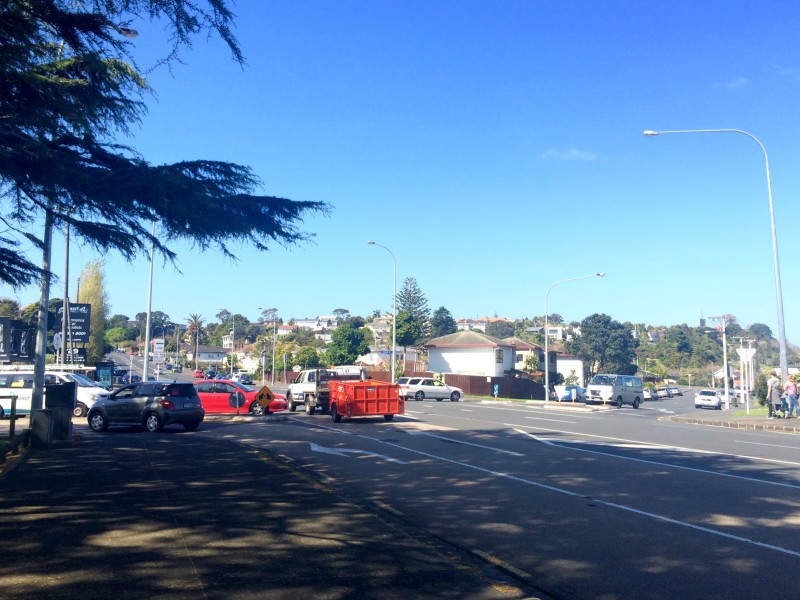

Visibility is key, and the bottom of the Bullock Track suffers in this regard from trees, road signs, corners and multiple lanes/ turning traffic. As cars on the bullock Track approach the intersection with Great North Road, visibility of the stop sign is also currently blocked by advertising from the car yard encroaching over the pavement. Due to the layout the bottom of the Bullock Track requires the driver to scan more than 180 degrees for approaching traffic. The local car yard also often parks cars on the footpath, making visibility worse.
Meanwhile on Great North Road: after passing MOTAT, citybound traffic splits into two lanes, one of which is a left turn only into the Bullock Track while the other continues straight ahead. This split occurs just after two lanes of through-traffic have merged into one, after crossing the intersection with Stadium Rd – so it’s a complex zone to traverse as a cyclist. At the intersection with the Bullock Track, this traffic also can turn right from the median strip into Tuarangi Road (which offers another rat run/shortcut to Grey Lynn or under the motorway to Western Springs).
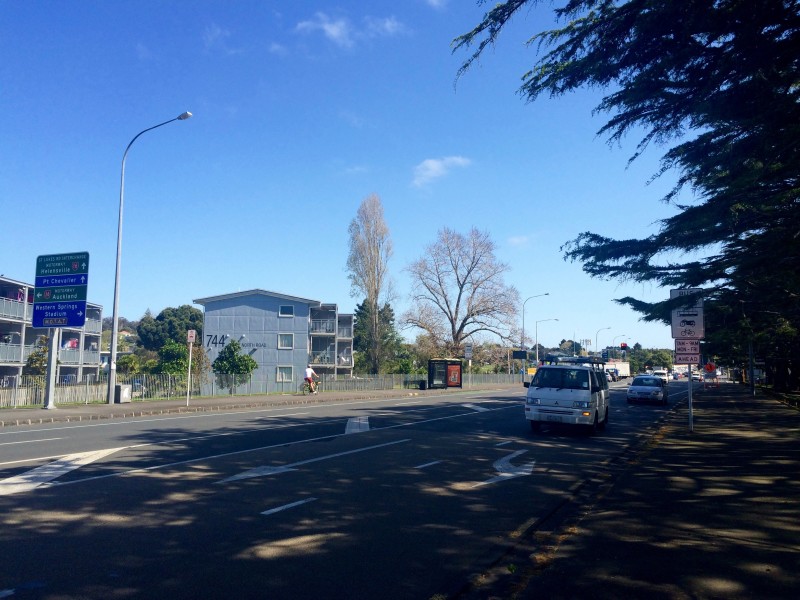
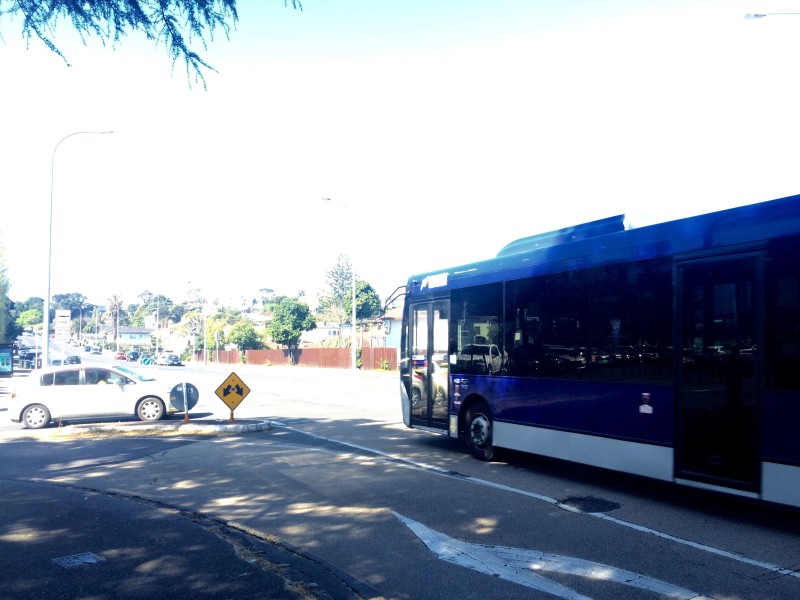
Traffic heading west from the CBD has three lanes to use, one of which is a bus lane. Again the two general traffic lanes split just prior to the intersection with the Bullock Track. Traffic headed towards MOTAT is not permitted to turn right into the Bullock Track.
Many if not most of the vehicles turning right out of the Bullock Track thus have to cross most of these lanes of traffic in order to position themselves to turn left onto the motorway only a few hundred meters up the road. Add in the heavy traffic, and this incentivises drivers to dash for gaps that aren’t really all that safe. And while doing so they tend to focus on cars, buses and trucks and are not looking for cyclists (or even if they are, they can get lost in all the action going on).
To make matters worse for cyclists, there is a recessed manhole cover in the lead-up to the intersection, with the choices being 1) veer slightly left to avoid it – putting the cyclist just inside the left-turn lane, and on a collision course with the traffic island – or 2) move well into the lane of traffic just as the lane is squeezed from both sides, due to said island on one hand and right-turning traffic waiting in the median strip on the other.
So why would anyone ride through there on a bike?
Well, the area is rich with family attractions such as MOTAT, Auckland Zoo and Western Springs Park. Additionally, it connects at one end to Ponsonby, Karangahape Road and the City, and to UNITEC at the other. It also happens to come officially recommended as a bike route…
We are fortunate in Auckland to have a number of projects funded by the government’s Urban Cycleways fund. NZTA proudly shows these projects in bright colours on their map. The map also shows Great North Road between Carrington Road and the intersection with Surrey Crescent shaded as an existing Cycleway. Auckland Transport, too, shows most of this section of Great North Road shaded as “Shared bus/cycle lane (transit)” on their Central Cycle Map, too. These maps are excellent resources. I have scanned the north, west and central cycle maps looking for alternative routes and safer alternatives, and normally I would be tempted by a route that offered bus lanes.
Even Google maps – which I sometimes use for some of my planning into new and uncharted territory, because of its excellent cycle route planner which knows about parks and paths – yes, even Google recommends using Great North Road.
So this intersection is simultaneously ranked as one of New Zealand’s most dangerous stretches of roads, and officially recommended for cycling.
[Editor’s note: Auckland Transport is currently considering removing most or all bus / transit lanes from inclusion in the “completed network” in its cycle network maps, acknowledging the issues many prospective riders have with riding under such conditions. However, this did not come in time for the maps of the Urban Cycleway announcement.
With the Urban Cycleway Programme, Great North Road east of Surrey Crescent is to get cycle facilities over the coming years (properly separated and not shared with buses!). While the programme’s extent does not reach as far west as the Bullock Track, this is likely to still raise cycle numbers on this section of Great North Road as well.
Great North Road is currently also an alternative to the current NW cycleway detour at St Luke’s in place until the end of 2015 – and we know many people are choosing to use it rather than taking the zig-zag detour through the back streets of Western Springs]
What do I, as a lay person, think could be done?
Firstly, I am not advocating that this route [Great North Road] should be lost to active transport modes. Quite the opposite: as it is an advertised cycling route, yet has the 7th highest-risk intersection in the country, it is urgently due for an upgrade. Here are some possibilities:
1. Ban traffic exiting from the Bullock Track onto Great North Road
Compare with the intersection of Church Street and Onewa Road in Northcote. There, traffic is allowed to turn into Church Street from Onewa Road, but traffic cannot join Onewa Road from Church Street.
To the best of my knowledge, there is one residence which is reliant on the Bullock Track and one business which has access to the Bullock Track as well as to Great North Road, so the inconvenience for local traffic is hopefully minor.
Preventing traffic turning out of the bottom of the Bullock Track would still allow Great North Road traffic to turn left into the Bullock Track. Traffic on the Bullock track wanting to join Great North Road would only need to head along Surrey Crescent or along Old Mill Road and Motions Road.
2. If that cannot be achieved then signalise the intersection
Signalising the intersection may be inevitable anyway, given issues with Tuarangi Road. Access to Tuarangi Road is busy, as it provides another path across (well, under) the motorway – and traffic turning in and out of Tuarangi Road poses a threat to cyclists heading westward (towards MOTAT) along Great North Road.
[Editor’s note: Cycle Action chased up progress at this intersection some weeks ago with Auckland Transport. Sadly, we got only very limited responses so far that did not fill us with confidence – see also our concern at Ngapipi Road about AT’s lack of urgency on these Top 10 crash risk intersections. We are particularly concerned about AT’s road safety team here, whose responsibility these are.]
3. If these solutions are not possible then other measures which would be less effective (in my mind, anyway) might include:
· Making the exit from the Bullock Track onto Great North Road a left only turn. The problem is this still requires vehicles to merge out into traffic. It would require island modification to ensure it was followed.
· Putting in a raised table or similar traffic calming across the bottom of the Bullock Track. A characteristic of my accident was that the driver slowed a little at first but did not come to a stop instead accelerating again past the stop sign from ~25kph while I was travelling along Great North Road in front of them.
After my accident, I researched the intersection and found this Ask Phoebe piece in the NZ Herald from 2013 – disappointingly, nothing seems to have come of this yet. Sooner rather than later, something will have to be done.
It would be a pity to have to have another fatality at this intersection before work commences.

